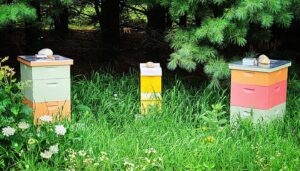Installing a windbreak on your property is a great way to practice conservation. The plants, animals, and buildings on your land will all benefit from protection and the filtering of wind and snow. The use of and considerations for Eastern White Pine as a windbreak are discussed.

This post contains affiliate links. As an Amazon Associate, I earn from qualifying purchases.
We own a beautiful 40-acre square of tillable land in southwestern Michigan. On it, we have a homestead, pastures, and a prairie that is currently enrolled in a conservation reserve program (CRP).
This is the land that I grew up on. When we built our home, there was nothing here besides grassland and the west wind whipped across the fields.
When I was around 7 years old, my dad decided to install a windbreak on the western border of our property. I remember helping transplant rows of young Eastern White Pine trees and watching them grow.
It was an investment that I am incredibly grateful for. Now, 30 years later, raising my own family here, we continue to reap the benefits of protection and wind filtering from this stand of pines.
Here are the reasons we love our windbreak and some considerations for constructing your own.
1. Windbreaks Protect Plants
High winds can be damaging to plants. We used to grow corn, and once the windbreak grew to a height of several feet, we experienced better yields. Now that the land is in a CRP instead of being farmed, the windbreak protects the native grasses and wildflowers from wind damage.
2. Windbreaks Protect Open Ground
We have some rolling hills on our property and the sandy hilltops are prone to erosion. A windbreak slows and filters the wind, making erosive wind damage on open ground less likely.
3. Windbreaks Protect Buildings
A windbreak can offer protection to your home or outbuildings. We have the windbreak on the western boundary of our property, but also a second smaller one to the west of our house.
4. Windbreaks Help Control Blowing and Drifting Snow
Having a windbreak is like having a living snow fence that helps control blowing and drifting. In southwestern Michigan, we get a lot of lake effect snow and the windbreak helps keep it manageable.
5. Windbreaks Provide Shelter for Livestock
We have horses and raise meat goats on our farm. When the animals are out on pasture and away from the barn, the windbreak is a way for them to find shelter and shade from the elements.
6. Windbreaks Provide Wildlife Habitat
Windbreaks can provide a sanctuary for wildlife. Our windbreak is a popular place for whitetail deer, rabbits, wild turkeys, and numerous species of birds. Since our property is completely open, it has attracted more game animals for hunting, which is an added bonus.
7. Windbreaks Help Pollinators
High winds can hinder the activity of pollinators like bees and butterflies. We keep honeybees and use our pines to provide protection to the hives, which we situated on the eastern side of the windbreak.

8. Windbreaks Provide Privacy
A windbreak is like a living privacy fence. If you would rather look at a row of trees than your neighbor’s property, a windbreak can be a way to enhance your view. Not only is our pine windbreak useful, but I find it beautiful too!
A Few More Things About Windbreaks
A windbreak should run perpendicular to the prevailing wind in your area. Our winds are usually out of the northwest or southwest, therefore our windbreak runs in a north/south direction with the ability to filter any western wind.
A windbreak should be semipermeable and should filter, instead of completely block the wind. White pines work well as a windbreak because they have branches all the way down their trunks and when planted in rows, provide a screen of filtration that can minimize even the harshest of winds.
We chose Eastern White Pine for our windbreak because they grow quickly and do well in our sandy soil. There may be other trees or shrubs that are a better choice for you, I recommend connecting with your local conservation district before you make any decisions.
Drawbacks of Natural Windbreaks
I just got done telling you how great windbreaks are, but they do come with a few drawbacks. One is that they can be costly. Purchasing hundreds of baby trees can get expensive, so this might be a project you have to save for.
Another disadvantage of a natural windbreak is that it takes time to grow them. It may be decades before your windbreak is fully functional. If you don’t plan on staying on your property long enough to enjoy the fruits of your labor, then maybe this investment doesn’t make sense.
The last downside is that windbreaks do require some maintenance. You will have to periodically trim and prune your trees and if one falls, clean it up. As the trees age, you might have to replace them as well.
There are alternatives to using trees and shrubs as windbreaks. Artificial windbreaks can be constructed with netting, mesh, or fencing materials. These don’t have all of the same benefits of a natural windbreak, but can provide some some protection and wind filtering.

Mother, farmer, author, and teacher by trade… She loves tending to things and watching them grow!
